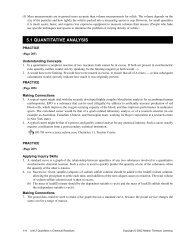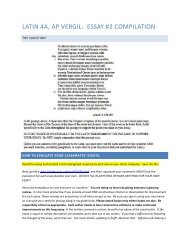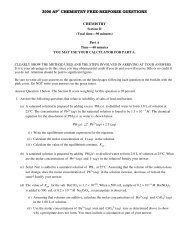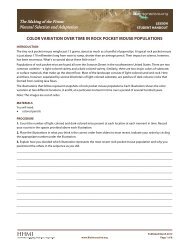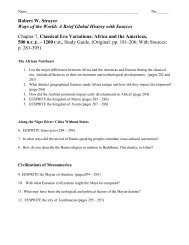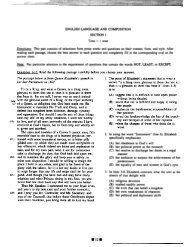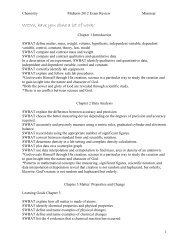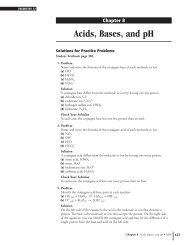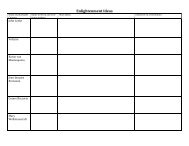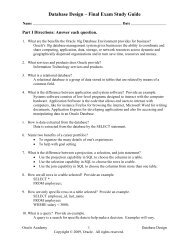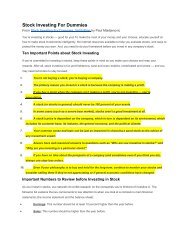Double replacement reactions and Net ionic equations ... - Quia
Double replacement reactions and Net ionic equations ... - Quia
Double replacement reactions and Net ionic equations ... - Quia
You also want an ePaper? Increase the reach of your titles
YUMPU automatically turns print PDFs into web optimized ePapers that Google loves.
Chemistry H /A<br />
Name_________________Date__________<br />
Lab – <strong>Double</strong> <strong>replacement</strong> <strong>reactions</strong> <strong>and</strong> <strong>Net</strong> <strong>ionic</strong> <strong>equations</strong><br />
<strong>Double</strong> <strong>replacement</strong> <strong>reactions</strong> involve <strong>reactions</strong> between ions in aqueous solutions. The polar nature of water makes it an<br />
effective solvent for many <strong>ionic</strong> solids; the dissolving process is referred to as solvation. It is important to remember that the<br />
solution remains electrically neutral because the ions’ charges cancel. The individual ions in the solution can move about<br />
independently, <strong>and</strong> can interact with other ions that are added to the solution. Of course, if the water were to evaporate, these<br />
ions would return to a crystalline solid. For example, in a common salt water solution there are an equal number of sodium ions<br />
(Na + ) <strong>and</strong> chloride ions (Cl -1 ) dispersed throughout the water molecules. If the water evaporates, the Na + ions <strong>and</strong> Cl -1 ions will<br />
be attracted to each other <strong>and</strong> solid NaCl will form.<br />
In this experiment, you will mix six <strong>ionic</strong> solutions, two at a time, to determine which combinations of ions form new<br />
compounds that are not soluble. If the “soup” of ions in the mixture contains a positive ion <strong>and</strong> a negative ion that attract each<br />
other so strongly that water will not hold them individually dispersed, you will notice a precipitate. These insoluble products<br />
are recognized by a cloudy or thickened appearance when two transparent solutions are mixed.<br />
This activity will give you practice at recognizing <strong>and</strong> writing chemical formulas, balancing double <strong>replacement</strong> <strong>equations</strong>,<br />
identifying precipitates, <strong>and</strong> writing net <strong>ionic</strong> <strong>equations</strong>. Your textbook supports these skills in Chapter 11 (in particular,<br />
section 11.3). Refer to the section as your analyze your lab results.<br />
Write formulas for the ions in each of the following compounds (incl. charge), <strong>and</strong> then write the formula for each<br />
compound. Two examples are given:<br />
sodium chloride Na 1+ Cl 1- NaCl<br />
calcium hydroxide Ca 2+ OH - Ca(OH) 2<br />
Name Ions present (incl. charges) Formula<br />
Silver nitrate<br />
Sodium chromate<br />
Aluminum sulfate<br />
Barium chloride<br />
Potassium chromate<br />
Strontium nitrate<br />
Procedure: Use clean, dry glass plates for the mixings – only a drop or two of each solution is needed. Be sure to allow<br />
sufficient time for each combination of ions to react.<br />
Report your observations in the data chart. For each combination of two solutions, record either “NR” (if no reaction occurs)<br />
or a brief description of the precipitate. You will need to write a balanced equation for any combinations that form<br />
precipitates.<br />
Use loose-leaf paper to complete the questions that accompany the lab.
Data: Observation Chart<br />
Silver<br />
nitrate<br />
Silver<br />
nitrate<br />
Aluminum<br />
sulfate<br />
Barium<br />
chloride<br />
Potassium<br />
chromate<br />
Strontium<br />
nitrate<br />
Sodium<br />
chromate<br />
Aluminum<br />
sulfate<br />
Barium<br />
chloride<br />
Potassium<br />
Chromate<br />
Strontium<br />
nitrate<br />
Sodium<br />
chromate<br />
Analysis: Follow these steps to write <strong>equations</strong> for each of the <strong>reactions</strong> you observed.<br />
Q1. Write a skeleton equation for each combination of solutions that formed a precipitate. Be sure to write individual<br />
formulas carefully – check charge, subscript agreement for each reactant <strong>and</strong> product. This is hard! You need to make it a<br />
habit to write products thoughtfully. Then add whole-number coefficients to make a balanced equation.<br />
Q2. Find the precipitate in the product: . Use a Solubility Table to identify which one of the two possible products in<br />
each case is insoluble. Mark the precipitate in each equation you have written for Q1.<br />
Honors only below this point. Text reference, 11.3.<br />
Q3. Now write an <strong>ionic</strong> equation exp<strong>and</strong> each balanced equation.. Here is an example of what to do: Consider mixing<br />
two solutions, CaBr 2 & K 2 CO 3. This reaction forms a cloudy white precipitate. The products would be KBr <strong>and</strong> CaCO 3 .<br />
So, your balanced equation would be: CaBr 2(aq) + K 2 CO 3(aq) CaCO 3 (s) + 2 KBr (aq)<br />
After checking solubility rules, you find out that CaCO 3 is insoluble. Therefore, the KBr remains dissolved as<br />
separate ions. Notice how the subscripts (aq) <strong>and</strong> (s) have been used. An <strong>ionic</strong> equation can be written for this<br />
reaction. Write all soluble species as separate ions. Write any precipitate a “new” compound. Again, use symbols<br />
to identify physical states of reactants <strong>and</strong> products: (aq) <strong>and</strong> (s) for solid.<br />
Ca 2+ (aq) + 2Br 1- (aq) + 2K 1+ 2-<br />
(aq) + CO 3 (aq) CaCO 3 (s) + 2 K 1+ (aq) + 2 Br 1- (aq)<br />
Q4. Simplify each <strong>ionic</strong> equation by leaving out any ions that appear on both sides of the equation. These are called<br />
spectator ions – they do not undergo any change in the chemical reaction. In the reaction above, Br -1 <strong>and</strong> K +1 ions are the<br />
spectator ions. (At this point in your work you should also reduce coefficients if possible.) The net <strong>ionic</strong> equation would<br />
be:<br />
Ca 2+ 2-<br />
(aq) + CO 3 (aq) CaCO 3 (s)<br />
Solubility Rules: The following rules are useful for predicting solubility in water.<br />
1. Salts containing alkali metal cations or ammonium are soluble.<br />
2. Salts containing nitrate, acetate, chlorate, or perchlorate anions are soluble.<br />
3. Salts containing chloride, bromide or iodide are soluble. (Except for Cu + , Ag + , Hg +2 2 <strong>and</strong> Pb +2 )<br />
4. Salts containing sulfate or sulfite are soluble. (Except Ca +2 , Ba +2 , Sr +2 <strong>and</strong> Pb +2 )<br />
5. Oxide <strong>and</strong> hydroxide salts are insoluble. (Except with group IA cations <strong>and</strong> ammonium.)<br />
6. Sulfide <strong>and</strong> hydrogen-sulfide salts are insoluble. (Except with group IA cations <strong>and</strong> ammonium.)<br />
7. Carbonate <strong>and</strong> chromate salts are insoluble. (Except with group IA <strong>and</strong> ammonium cations <strong>and</strong> ammonium.)




